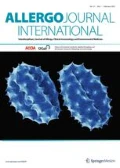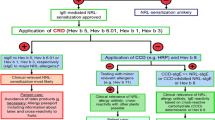Abstract
The official WHO/IUIS database (www.allergen.org) currently lists 77 mould allergens from a variety of protein families. To date, only eight recombinant single allergens from three mould species are available for molecular allergy diagnosis of mould sensitization. These include rAlt a 1, the major allergen in Alternaria alternata-sensitized individuals, and enolase rAlt a 6 with it potential cross-reactivity to mould, food and natural latex allergens. rAsp f 1, 2, 3, 4 and 6 from Aspergillus fumigatus are available for diagnostic purposes; specific IgE to rAsp f 2, 4 and 6 is often positive in allergic bronchopulmonary aspergillosis (ABPA). The dehydrogenase rCla h 8 is considered a major allergen of Cladosporium herbarum with possible cross-reactivity to other dehydrogenase allergens. The narrow range of commercially available individual mould allergens should be expanded to include marker allergens typical for mould (e.g., serine proteases). In addition, standardization of total extracts needs to be improved in the future to guarantee valid mould products with defined allergen content for diagnostic and therapeutic purposes.


Similar content being viewed by others
Abbreviations
- ABPA:
-
Allergic bronchopulmonary aspergillosis
- FAD:
-
Flavin adenine dinucleotide
- HSP:
-
Heat shock proteins
- IgE:
-
Immunglobulin E
- IUIS:
-
International Union of Immunological Societies
- MnSOD:
-
Manganese superoxide dismutases
- NAD:
-
Nicotinamide adenine dinucleotide
- WHO:
-
World Health Organization
References
Haftenberger M, Laußmann D, Ellert U, Kalcklösch M, Langen U, Schlaud M et al. Prävalenz von Sensibilisierungen gegen Inhalations- und Nahrungsmittelallergene - Ergebnisse der Studie zur Gesundheit Erwachsener in Deutschland (DEGS1). Bundesgesundheitsblatt 2013; 56: 687–97
Schmitz R, Ellert U, Kalcklösch M, Dahm S, Thamm M. Patterns of sensitization to inhalant and food allergens - findings from the German Health Interview and Examination Survey for Children and Adolescents. Int Arch Allergy Immunol 2013; 162: 263–70
Heinzerling LM, Burbach GJ, Edenharter G, Bachert C, Bindslev-Jensen C, Bonini S et al. GA(2)LEN skin test study I: GA(2)LEN harmonization of skin prick testing: novel sensitization patterns for inhalant allergens in Europe. Allergy 2009; 64: 1498–506
Simon-Nobbe B, Denk U, Pöll V, Rid R, Breitenbach M. The spectrum of fungal allergy. Int Arch Allergy Immunol 2008; 145: 58–86
O’Driscoll BR, Powell G, Chew F, Niven RM, Miles JF, Vyas A et al. Comparison of skin prick tests with specific serum immunoglobulin E in the diagnosis of fungal sensitization in patients with severe asthma. Clin Exp Allergy 2009; 39: 1677–83
Mayer C, Appenzeller U, Seelbach H, Achatz G, Oberkofler H, Breitenbach M et al. Humoral and cell-mediated autoimmune reactions to human acidic ribosomal P2 protein in individuals sensitized to Aspergillus fumigatus P2 protein. J Exp Med 1999; 189: 1507–12
Achatz G, Oberkofler H, Lechenauer E, Simon B, Unger A, Kandler D et al. Molecular cloning of major and minor allergens of Alternaria alternata and Cladosporium herbarum. Mol Immunol 1995; 32: 213–27
Wagner S, Breiteneder H, Simon-Nobbe B, Susani M, Krebitz M, Niggemann B et al. Hev b 9, an enolase and a new cross-reactive allergen from Hevea latex and molds. Purification, characterization, cloning and expression. Eur J Biochem 2000; 267: 7006–14
Lai HY, Tam MF, Tang RB, Chou H, Chang CY, Tsai JJ et al. cDNA cloning and immunological characterization of a newly identified enolase allergen from Penicillium citrinum and Aspergillus fumigatus. Int Arch Allergy Immunol 2002; 121: 181–90
Schneider PB, Denk U, Breitenbach M, Richter K, Schmid-Grendelmeier P, Nobbe S et al. Alternaria alternata NADPdependent mannitol dehydrogenase is an important fungal allergen. Clin Exp Allergy 2006; 36: 1513–24
Kespohl S, Maryska S, Zahradnik E, Sander I, Brüning T, Raulf-Heimsoth M. Biochemical and immunological analysis of mould skin prick test solution: current status of standardization. Clin Exp Allergy 2013; 43:1286–96
Chruszcz M, Chapman MD, Osinski T, Solberg R, Demas M, Porebski PJ et al. Alternaria alternata allergen Alt a 1: a unique β barrel protein dimer found exclusively in fungi. J Allergy Clin Immunol 2012; 130: 241–7
Unger A, Stöger P, Simon-Nobbe B, Susani M, Crameri R, Ebner C et al. Clinical testing of recombinant allergens of the mold Alternaria alternata. Int Arch Allergy Immunol 1999; 118: 220–1
Kurup VP, Banerjee B, Hemmann S, Greenberger PA, Blaser K, Crameri R: Selected recombinant Aspergillus fumigatus allergens bind specifically to IgE in ABPA. Clin Exp Allergy 2000; 30: 988–93
Author information
Authors and Affiliations
Corresponding author
Additional information
Conflict of interest
The authors declare that no conflicts of interests exist.
Cite this as Kespohl S, Raulf M. Mould allergens: Where do we stand with molecular allergy diagnostics? Part 13 of the series Molecular Allergology. Allergo J Int 2014; 23: 120–5
Rights and permissions
About this article
Cite this article
Kespohl, S., Raulf, M. Mould allergens: Where do we stand with molecular allergy diagnostics?. Allergo J Int 23, 120–125 (2014). https://doi.org/10.1007/s40629-014-0014-4
Received:
Accepted:
Published:
Issue Date:
DOI: https://doi.org/10.1007/s40629-014-0014-4




